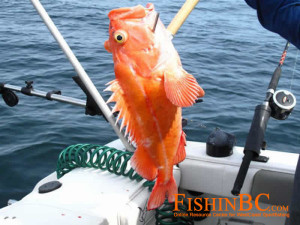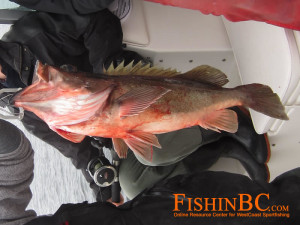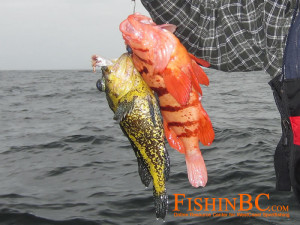
US Department of Commerce
National Oceanic and Atmospheric Administration
National Marine Fisheries Service
Alaska Fisheries Science Center
There are two editions, first and second. Of note, the first edition has been converted into a user friendly interactive Rockfish ID website, while the second version has not been converted to a website that I am aware but is available for PDF download and printing, so you can take it out on your boat. Each Rockfish ID guide can be accessed by clicking on the citation title:
First Edition: (link will open Rockfish ID Interactive Website – Alaska Fisheries Science Center)
[button class=”btn_smallred” url=”http://www.afsc.noaa.gov/groundfish/RockfishGuide/rockfishtoc.htm” text=”Link: First edition”]
Second Edition: (link will open Rockfish ID PDF document – Alaska Fisheries Science Center)
[button class=”btn_smallred” url=”http://www.afsc.noaa.gov/Publications/AFSC-TM/NOAA-TM-AFSC-117.pdf” title=”NOAA Technical Memo NMFS-AFSC-117 Guide to Rockfishes (2000)” text=”Link: Second Edition”]
Rockfish Id Method
The following Rockfish ID method is quoted from the NOAA Technical Memorandum NMFS-AFSC-95:
Species are grouped into five color categories: Red, Black, Red/Black, Banded (“Striped” of Hitz, 1965), or White-Spotted Red. Within these categories, species are sorted by head spines strength (weak or strong). Finally, species are grouped together based on the authors’ ideas of externally similar species. However, because species are first sorted by color and head spine strength, the most similar species may not be grouped together.
1. Determine the color category, using the following guidelines:
- Red category rockfishes (28 species)
- possess a light background coloration of orange, yellow, or, most commonly, red. Typically, dark blotches are present on the back and often extend from the base of the dorsal fin to below the lateral line; these blotches may be diffuse or relatively discrete. The infrequent dark phase of some typically red rockfishes is noted under the description of body color. In general, dark red-category rockfishes have a much redder body than black category rockfishes.
- Black category rockfishes (18 species)
- have a predominantly dark background coloration. Most are a uniform dark color, ranging from black to brown with darker blotching or pale areas on the dorsum and lightening to white, gray, or pink ventrally. Others, often more shallow water species, may display strongly contrasting colors such as black and yellow.
- Red/black category rockfishes (7 species)
- possess almost equal proportions of light and dark colors, as the label suggests, which makes selecting either the red or black category difficult. No unifying color pattern is apparent among these fishes; however, a characteristic color combination (e.g., horizontal green striping in greenstriped rockfish, Sebastes elongatus, and the pink pectoral-fin slash in northern rockfish, S. polyspinis) is often sufficient for identification.
- Banded category rockfishes (4 species)
- possess 4-6 discrete vertical bands of dark color (red to black) on a light background of white, pink, or yellow.
- White-spotted red category rockfishes (12 species)
- possess a light colored body with 2-5 pale areas (i.e., spots) above the lateral line.
2. Determine head spine strength [FishinBC.COM note – head spines are small spines on the head of the fish near the eyes, do not misinterpret as the dorsal fin spines]
- After placing the fish in a color category, visually estimate the prominence of the eight pairs of head spines (see page 6 [of the referenced document] for positions and numbers of spines).
- Generally if the spines, especially those nearest the orbit (numbers 2-5), are easily visible at about elbow’s length, the spines are considered strong.
- Otherwise, the spines should be considered weak.
3. Count head spines:
- Head spines should be counted to determine which pairs of the eight possible are present. For each species, a diagrammatic dorsal view of the rockfish’s head is provided.
- A number with a line to the head indicates that the spine is typically present in large juveniles and adults; if a number has no line, the spine is typically absent. A number in parentheses indicates that the spine may be present or absent.
- Variation in the presence of head spines has not been quantified for most species, thus parentheses may indicate either that the spine is typically present but often absent or vice versa.
- Often spines are lost with body growth, and juveniles typically have more and stronger spines than adults.
- For example, dusky rockfish, S. ciliatus, is known for having a smooth head with reduced or absent spines, yet small juveniles possess head spines 1, 2, 4, 5, and 7 that are moderately strong.
- Thus this guide is primarily for adults and large juveniles that have developed the adult morphology.
- To identify smaller and pelagic juveniles, use the following guides to early life history stages: Matarese et al. (1989) or Moser et al. (1996).
With the information from these three characters, choices should be narrowed to two or three rockfishes.
- Around most of the figures in the guide, a combination of characters are highlighted that, when present, distinguish the species from all others.
- Along with these specific characters, two additional features depicted in the figure are often useful in distinguishing similar species:
- second anal-fin length relative to third and
- mouth size, as reflected in maxilla length.
- Many of these characters are subjective as well as variable and, therefore, depend on the experience of the user to be used properly.
- To confirm the identification, use the similar species section to check particular characters.
- Next to the name of each similar species, characters are listed based on the relative ease of determination and the usefulness of the feature to clearly distinguish between the two species.
- Finally, check the specimen against other characters provided, such as peritoneum color and shape between the eyes, and habitat information, such as depth and distribution.
The photographs and figures themselves should only be used as a guide to the appearance of the fish. Photographs in species accounts are generally taken from trawl caught specimens with fresh coloration. Most line drawings have been drawn from specimens or photographs and accurately represent the dark and light patterns and body shape of that specimen. However, many of these features often vary among populations and, in many species, among individuals of a given population.

Good luck on your next fishing trip and hopefully you can put these Rockfish ID resources to good use!
Your Turn !
Now that you’ve read the whole article, give me a shoutout – write in the comment box and let me know what you think about this article and if there is any additional or different information you’d like to know. And if you enjoyed this article, be sure to tweet, like, and G+1 this page so other anglers can find it too, and join the official Fishin BC facebook page to stay in touch with our latest news. Tight lines…FishinBC.COM.
